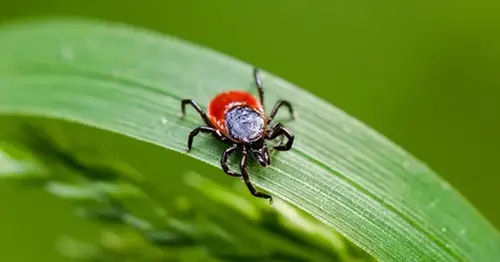
Cases of tick-borne babesiosis disease are rising, CDC says
Babesiosis, a tick-borne disease that can be fatal in rare cases, is becoming more prevalent in the Northeast, according to a report released Thursday by the Centers for Disease Control and Prevention.
The findings show that among the 10 states that reported babesiosis cases from 2011 to 2019, eight saw their numbers rise, while just two — Minnesota and Wisconsin — observed declines.
What's more, babesiosis in now considered endemic in three new states: Maine, New Hampshire and Vermont. Previously, the disease was only considered endemic in Connecticut, Massachusetts, Minnesota, New Jersey, New York, Rhode Island and Wisconsin.
"Nine years of data show [an] increase in tickborne disease in parts of the U.S. that previously saw few cases," said Megan Swanson, an epidemiologist with the CDC’s Division of Parasitic Diseases and Malaria, who co-authored the report.
Symptoms of babesiosis include fever, chills, sweats, headaches, body aches, nausea, fatigue or muscle and joint pain. The disease has an overall fatality rate of around 1% to 2%, according to Dr. Peter Krause, a senior research scientist at the Yale School of Public Health, who was not involved in the CDC study.
Up to 20% of adult cases and 50% of pediatric cases are asymptomatic. Older or immunocompromised people are most vulnerable to severe outcomes like low blood platelet counts, kidney failure or acute respiratory distress syndrome, in which fluid builds up in the lungs.
The report highlights “an unfortunate milestone in the emergence of babesiosis in the United States,” Krause said. “More cases means more illness, and actually, some people die.”
Babesiosis can be more severe than Lyme disease
Humans largely acquire babesiosis from deer ticks, whose bites can transmit Babesia parasites that infect red blood cells.
Most transmission occurs from late May to early September. Researchers think that as climate change drives longer periods of humidity, that creates more hospitable environments for ticks.
“The ticks are surviving better in the winter, and so the next spring, you have more ticks to bite more people,” said Edouard Vannier, an assistant professor who studies babesiosis at Tufts Medical Center and wasn’t involved in the report.
The new data show that the number of babesiosis cases rose 17-fold in Vermont and more than 34-fold in Maine from 2011 to 2019.
Babesiosis can occasionally be confused with Lyme disease, another tick-borne illness that causes fever and muscle aches. Whereas Lyme disease has a defining feature — a rash at the site of the tick bite — Krause said there isn’t an obvious babesiosis symptom. It's usually diagnosed via a blood test.
“Sometimes the patient will have felt just fatigued and not quite right, maybe a low grade temp for a week or two, and then all of a sudden they get worse,” Krause said. “That’s usually not the case with Lyme — you get it and then, bingo, you have the rash and so on.”
Babesiosis tends to be more severe than Lyme disease, though Lyme is far more common. The CDC records around 30,000 cases of Lyme disease each year, whereas around 16,500 total cases of babesiosis were recorded from 2011 to 2019.
People can get both diseases at once, Vannier said. He estimated that about half of people with babesiosis also have Lyme disease.
A rise in tick-borne disease
Scientists identified the first human case of babesiosis in the U.S. in 1969. Its increasing prevalence has coincided with an overall rise in tick-borne disease, which rose 25% from 2011 to 2019. From 1999 to 2019, confirmed cases of Lyme disease rose 44%.
Researchers attribute the trend to a few factors. For one, deer populations have expanded, giving ticks more opportunities to feed and reproduce. People are also increasingly traveling to and building homes in forested areas.
On top of that, rising global temperatures have resulted in longer summers and shorter winters, and ticks thrive in warm, humid climates.
Krause also noted that older people have come to represent a larger share of the population, and they are more vulnerable to severe babesiosis, therefore more likely to get an official diagnosis.
“It tends to be the more severe cases, the ones that get into the hospital, that are reported," he said.
The CDC report recommended that people who spend time outdoors in states where babesiosis is endemic wear long pants, use tick repellant and avoid underbrush and long grass.
Researchers said babesiosis is likely more prevalent than the CDC count suggests, given asymptomatic infections and that not all physicians flag cases to state health departments and not all states report cases to the CDC.
Source: https://www.nbcnews.com/health/health-news/tick-borne-babesiosis-disease-cases-rising-cdc-rcna75276






